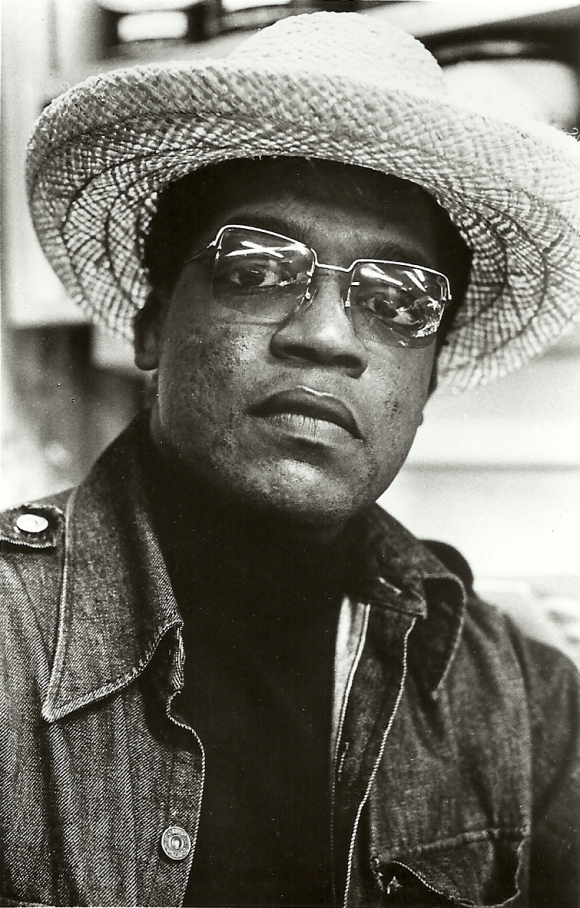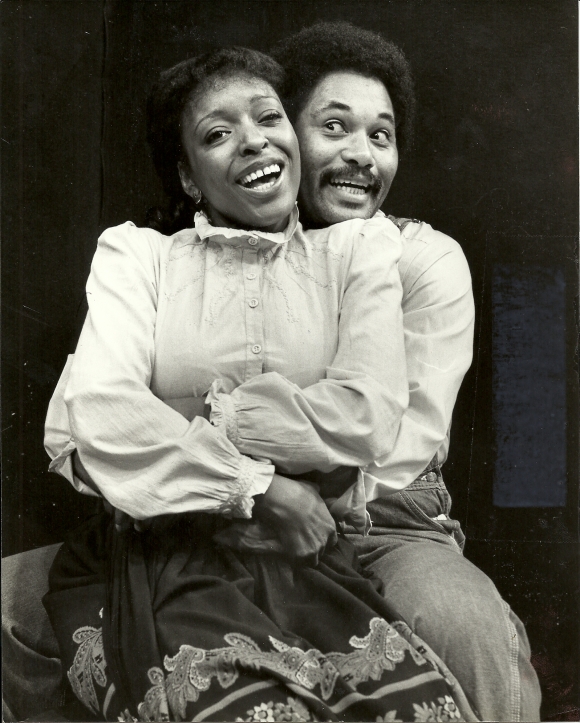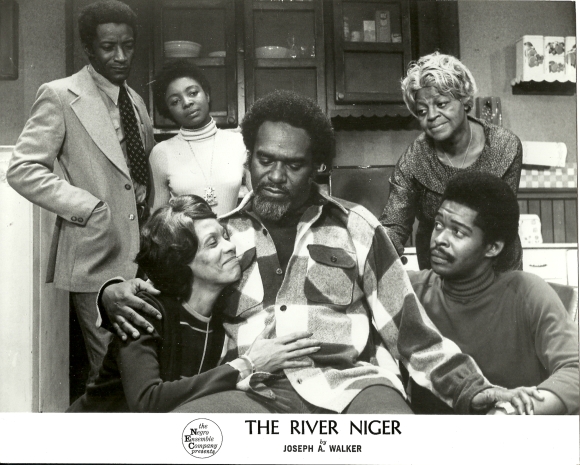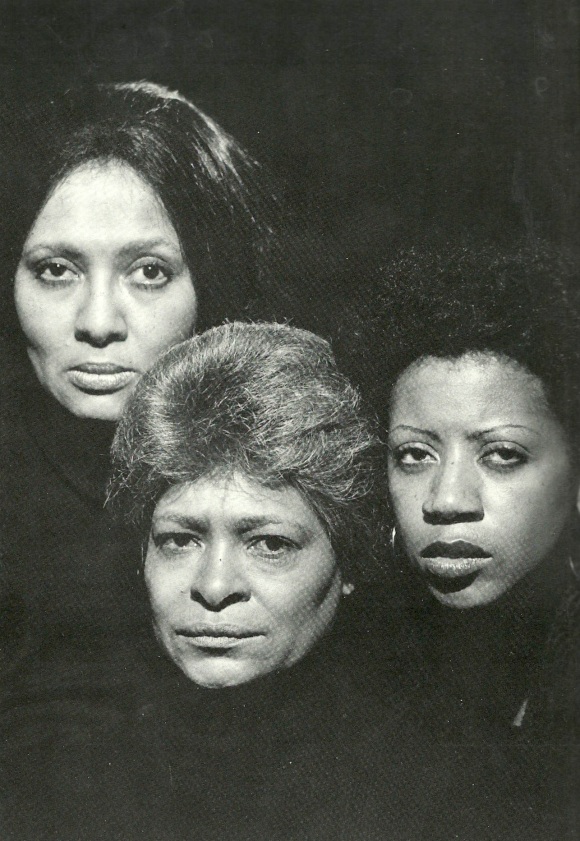The MacDaddy Experience or Ode to the Palm-Wine Drinkard
It was the best of times, it was the worst of times, but these were the times of Wine. It flowed like Black Magic and it spilled into the streets. Wine represented high times for Black culture, consciousness and politics. It was the mid 70’s, a time when Black music, dance and theatre was flowing from every corner of New York City. There was a rich new cultural renaissance on the horizon, which started in the late 1960s and swept the country, from New York to Los Angeles, all points north, south and a few in between. The abundance of this inspiring new theatre fed the masses and gave Black folks choices as they packed the halls of entertainment with great enthusiasm. The generous grape vines of federal and corporate funding were loaded with sources and a hungry public demanded more as new theatre groups sprang forth, and thrived.

In NYC from Harlem to the Lower East Side, to Brooklyn, there were at least thirty different theatre companies. On any given night there were fifteen to twenty black theatre productions to choose, from Robert MacBeth’s New Lafayette Theatre, Roger Furman’s New Heritage Theatre, Al Fann’s Theatrical Ensemble, in Harlem, Garland Thompson’s The Frank Silvera Writers Workshop in mid-town, Douglas Turner Ward, Gerald Krone and Bobby Hooks’ Negro Ensemble Company, Buddy Butler’s Theatre Black, of which I was Vice-President, and Woodie King, Jr’s New Federal Theatre in the East Village and Lower East Side. Hell, on any night, there were at least two or three Black productions running at the New York Shakespeare Festival, just around the corner from NEC, which was constantly pumping out epic folk plays, like Errol Hill’s Man Batter Man, Wole Soyinka’s Kongi’s Harvest, and Derek Walcott s’ Dream on Monkey Mountain.
Joseph Papp had such a passion for Black theatre that he produced very new, exciting, and sometimes, controversial black plays in his theatres, from Lincoln Center to Broadway and at the Shakespeare Festival. He was bold enough to produce a very explosive revolutionary play by Richard Wesley, entitled “Black Terror”. “Black Terror’ was originally produced by WASTSA! Theatre Group, an ensemble company which I co-founded with a group of students while attending Howard U. The Point is; all of this wine flowed at the same time. I mean, folks were in the streets and work was plentiful for Black performers. Jazz and dance was at its apex. New Jersey had Imamu Baraka and his Spirit House Movers in Newark, Brooklyn had Delano Stewart’s Bed-Stuy Theatre, the Billie Holiday Theatre and the dynamic soldier, and friend, brother Yusef Iman, with his incredible family of Boot Dancers, musicians and storytellers.

Broadway turned out exciting Black musical productions, such as “Bubbling Brown Sugar”, “Purlie”, “Don’t Bother Me I Can’t Cope,” “Raisin” and “Ain’t Suppose to Die A Natural Death”, of which I am proud to admit that I was a young, excited and a willing participant. It gave me the opportunity to work all of the folks I was close to and learned from, like Dick (Big Time Buck White) Anthony Williams and his wife, Gloria, Bill Duke, Garrett Morris, Joe Fields, Arthur French, Mama Minnie Gentry, Carl Gordon, Cleabert Ford, Barbara (Lillie Did the Zampogiooooogi) Alston, Joe Fields, Gloria Schultz, Madge Wells, Albert Hall, Jimmy Hayerson, Ralph Wilcox, Tony Brealand and the fabulous Ms. Bea Winde. Working with this group of poets, prophets and storytellers, I learned something new everyday about life, living and the tricks of the trade. It was a Total Ensemble Theatre experience. Buy the way, I must admit… and quiet as it was kept… the “Ain’t…” concept was originally created, and directed by one of my former instructors at Howard University, Professor Paul Carter Harrison (remember that name). He conceived and directed the show while teaching at Sacramento State University, in California. Now, “Ain’t…” was a high point for me and for theatre in New York at that time because “the joint was really Jumpin’”. I was a young “whipper snapper”, a couple of years out of Howard University, a farther, attending graduate school at NYU, performing with Theatre Black, designing lighting and doing technical theatre between NEC, New Federal Theatre at Henry Street and the New York Shakespeare Festival… and at most times… at the same time. Buddy (Putney Swope) Butler, my former roommate, from HU and NY, and I were the technical wizards, but Ed Burbridge was “The Man”. All of this activity was within walking distance from NYU.
CUT TO: A few years later and a brief lull in the action, around the early Spring of 74’. I was coming out of a record shop on St. Marks Ave. down in the East Village-Low. I ran into a friend who told me he had just come from an audition at the NEC, just around the corner. I asked… “What was the title of the play?” He said, “Man it was a wild piece called “The Great MacDaddy”, by some dude name Paul Harrison, he was upstairs right now with Doug” on the third flo”. I asked him if he knew who Paul Carter Harrison was. He said, “No, but cat wrote some crazy $#!% with some way out wit, about Shine and Stackolee and them”. I asked him, “Did he make it?” He said, “Man, I couldn’t shake, cause’ it was a bit to out there for me”. I told him I knew Paul, he was one my teachers at The Hall, and he said “Then you better run up and talk to him. Now I knew that Paul had also developed the MacDaddy tale while he was at Sac State, and it was destined to be a big hit. In fact, his history and his works were part of my Masters thesis while attending the University of the Streets… I mean NYU, just down the street. It was a matter of timing and the stars aligning, cause’ the public had to be hip and ready for this. Paul and I go back to HU, where he introduced to us to his Drama of Nommo, and Do.

You see, the Black oral tradition is about myth and superstition, the marchings, the struggles and the Souls of Black Folk, from heaven to perdition. Mischief makers, heart breakers, cradle shakers and soul takers, like Robert Johnson at the Crossroads of life. These were tall tales left us by slaves, prisoners and old men in baggy dungarees, smoking Bull Durham tobacco in their home made corn cob pipes while swigging on bottles of Jack Danials or White Lightnin’. It was called lyin’ and signifyin’ on street corners, back porches, and barber shops, like Iceberg Slim, Willie Best, Oscar Brown, Jr. and nem. At least that’s the way it was where I came from. You see, our history was not written, by us, but passed on orally from generation to generation. In passing these tales on, the stories got longer, the myth got stronger and the hero got bigger and bad-er. I cut my teeth listening to these tales while growing up in Anderson, South Carolina. It was the rap of our generation, our way of preserving a nation, while wondering far, far away from home. It is a journey for young men to remember and pass on to their gender… sons… to be keepers of the eternal flame and masters of the MacDaddy game. One lesson you learn real early; if you messin’ with another man’s Shirley. The tongue is only six inches long, yet it can destroy a man six feet tall. If you couldn’t fight and were a bit too light, you had to be fleet of foot and quick out of sight. These tales also helped to prevent young men from becoming all limp in the wrist…and Do. It is a lost art, a protective coating, the ability to blab, the gift of gab, the battle between good, bad, the almost had, the battle between mischief and the Devil. The “Bad” in this case meant “Cool”… Like, “I know where light goes when you turn the switch off “Cool”. Fact and mythology were woven together into a tapestry of our history and our hero and sheroes were to be treasured. In every tall tale there was a truth to be told about love, struggle, defiance, negritude, manhood, joy and Nommo. Na-mean?
ANYWAY…Signifyin Monkey, Shine, Wine and bad ass Stackolee, grew up in a place where I come from. In fact, they didn’t live too far from me. It was like a dream come true, and up the stairs I flew to meet Mr. MacDaddy… and do. I really wanted to work with Doug and Paul. Doug was directing the show and all, and they asked me what I wanted to do. I said “Ohhhh, I don’t know, gentlemen. I called em’ gentlemen…ya’ know? I said, “I can do a number of things but I just dropped in to see you. What would you like for me to do?“ They looked at each other, did a wise man chuckle and Doug asked me if I was familiar with “Shine”. I asked, “Are elephants heavy… Is water wet? I can do Shine, you bet”. I glanced at the script and went for what I knew, for it was all in the back of my head. There are about a hundred and thirty stanzas, depending on who’s tellin’ the tale…Or is it an hundred and thirty two? I did a few lines about the Captain and his jive daughter, I out swam the Shark, I even walked on water. I finished my bit and about ready to split, when they both walked over and shook my hand. Paul had a big smile as he slapped me on the back and said, “Nice, let me walk you out”. I turned and looked at Doug, he had a big grin on his mug. He said, “Now, that’s what I’m talkin’ about”. Now, Doug was also known for flippin’ a tale, or two, he’s an also an escape from down younder to. So, Paul is the Griot who spun the yarn, and wove the tale of the tapestry of Big MacDaddy …and Do.
I’m sure Amos Tutuola would throw up his hands and holler if he could see and hear his tales from the bush adapted to contemporary theatre.
The Great MacDaddy is one of the most significant plays in the black canon today, but the world has yet to really experience its magic. It was one of the most significant and fulfilling events of my career and in my life. It was another opportunity to work with folks whom I admired, respected and learned a performance trick or two. The list includes Sir Graham Brown, Al Freeman, Jr., Adolph Caesar, Hattie, Winston, Cleavon Little, Charles Weldon, Roscoe Orman, Felicia Rashad, Marjorie Barnes, David Downing, Dyane Harvey, Bebe Drake Hooks, Alton Lathrop, Howard Porter, Alvin Ron Pratt, Freda Vanterpool, Victor Willis, Coleridge Tyler Perkinson, Dianne McIntyre, Douglass Turner Ward and Paul.

There was In the Wine Time and What The Wine-Sellers Buy, but the Great MacDaddy was the best Wine of all. It is a poetic compilation of our myth and history in this country and is a reflection of the social condition. It spans the test of time and can be adapted to every generation while remaining a literary mystery. With the evolution of our language, music, dance, lifestyles and constantly shifting social restrictions, the more things change, the more they stay the same. It is being revived to bring back a golden time forgotten tradition, and to inspire a new generation of storytellers…but most important of all… to bring back the times of Wine.
“So, I saved the lady from the complete gentleman in the market who afterwards reduced to a “Skull” and the lady became my wife since that day. This is how I got a wife.” (Chapter 11,…
“This old man was not really a man, he was a god and he was eating with his wife when I reached there . . . I myself was a god and juju-man.” (Chapter 1, p. 194)
Amos Tutuola – from The Palm Wine Drinkard
“… he is the greatest MacDaddy of all the MacDaddys, who can do anything in this world. PCH
Sati Jamal
10/2012











































